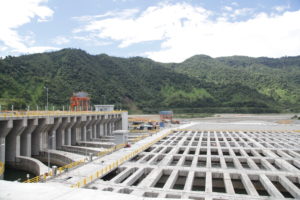From the beginning, it generated more doubt than certainty. And to this day, it has never generated its total installed power capacity. The Coca Codo Sinclair hydroelectric plant cost more than US$3.2 billion, making it the most expensive infrastructure project in Ecuador’s history. Yet, its many flaws are turning it into a white elephant in the middle of the Amazon and prompting national energy planners into a rethink.
Israeli, Iranian and Brazilian companies were among those to bid for the mega-project. But it was China’s Sinohydro that won, backed by a US$1.7 billion loan from The Export-Import (Exim) Bank of China that, like most loans, came with certain conditions. In this case, they included contracting a Chinese company to execute the project.
Construction of Coca Codo Sinclair began in 2006 and was presented as a symbol of a hydropower revolution in Ecuador’s energy sector, under the government of former president Rafael Correa (2007–2017).
“This work will be the engine of new companies, of entrepreneurship, of research, of industrialisation, of the Ecuador of the future. From here, the energy to make the leap to development will come,” Jorge Glas, former vice-president of Ecuador, told an audience that included China’s president Xi Jinping at the November 2016 inauguration of the plant.
However, the plant has been undergoing repairs ever since. Recently, the situation has deteriorated drastically with the erosion of the Coca river – its lifeblood. What went wrong?
Ignoring the studies
In 1992, Ecuador spent US$20 million on two feasibility studies for Coca Codo. Both confirmed the feasibility and necessity of its construction. However, their adequacy has been called into question. “To date, the power plant still lacks vulnerability and risk studies,” said Luis Torres, a geologist and advisor based in Quito.
The plant was originally conceived as a two-stage project with an output of 859 megawatts (MW). Some 18 years after the original studies were first commissioned, former president Correa initiated construction. The then Minister of Electricity and Renewable Energies, Alecksey Mosquera, indicated that it would be executed in a single stage, with an installed capacity of 1,500 MW – almost double the recommended amount. The National Electricity Council (Conelec) justified this by arguing that the studies were not recent, but they allowed for an increase in capacity.
Ecuador’s famous San Rafael waterfall, pictured before and after drying up in February 2020. Many have pointed to the Coca Codo project as the main contributing factor. (Before image: Ministry of Tourism Ecuador. After image: Ministry of Environment Ecuador)
Fabricio Yépez, a professor in civil engineering at the Universidad San Francisco de Quito, told Diálogo Chino that the 1992 studies established a risk to the water supply of the iconic San Rafael waterfall. The report found that if it dried up – as happened in February 2020 – it could trigger a process of “regressive erosion”, eating up the river bed and destabilising land upstream, and jeopardising Coca Codo’s own diversion reservoir.
In April 2020, erosion caused the Trans-Ecuadorian Oil Pipeline System (SOTE) and the Heavy Crude Oil Pipeline (OCP) to rupture.
Urgent risk assessments are now needed, according to Yépez: “This type of project needs technical decisions in order to avoid suffering millions of dollars in losses,” adding that the contractor should have carried out definitive studies for the project.
No supervision or control
Coca Coda Sinclair is currently managed by a consortium consisting of local firms Consultora Vera y Asociados and Ingenieros Consultores Asociados, alongside the Mexican state-owned Comisión Federal de Electricidad (CFE) and its compatriot Grupo Profesional Planeación y Proyectos (PYPSA). Despite being paid more than US$128 million for their services, the consortium has caused headaches for the Ecuadorian state. On 29 September, the Corporación Eléctrica del Ecuador (Celec) announced that it will sue for irregularities, including receiving components with notable damage.

“The auditors allowed this equipment to be covered with tons of concrete, despite the flaws,” Orozco said. “The consortium recommended that these faults be repaired by welding. They originated in the factory and were evident in 2015, when a re-inspection was carried out and determined that several of the quality [control] documents did not coincide with what was established on site.”
Non-priority investment
Coca Codo Sinclair should produce more energy than Ecuador needs. Since 2020, however, it has faced recurrent stoppages due to damage to its intake structures, caused by erosion. From May to November this year, Sinohydro repaired internal cracks that were present even before the inauguration. During these months, the plant operated at less than half its capacity.
By 15 November, the work was complete. According to Celec, this would allow it to return to 100% of its installed capacity. However, access to reliable energy information means this is difficult to confirm.
92%
Hydropower accounts for 92% of Ecuador's energy production
According to the national electricity operator, Cenace, hydroelectric projects produce 92% of Ecuador’s energy, of which 28% comes from Coca Codo. In total, the nation has around 5,000 MW in installed hydroelectric capacity, contributing to a surplus production that, since 2015, has been exported to Colombia and Peru. Cenace figures state that 2020 energy sales were worth US$55 million.
Given Ecuador’s surplus production and the environmental impacts associated with the Coca Codo Sinclair project, Yépez says it was, ultimately, unnecessary: “Since 2009…it was already known that due to the conditions of the site and the river, it would not be possible to generate 1,500 MW. Nor are they necessary.”
The project has also run into obstacles in covering costs through insurance. Seventeen Celec-owned projects have a risk policy with the state-owned insurer Seguros Sucre; Coca Codo Sinclair’s agreement expired on 1 August this year. In five years of operation, Coca Codo has undergone constant repairs, works that have cost the country US$8 million, according to Orozco.
The insurer does not cover damages that it deems preventable, such as erosion and corrosion, Patricio Salas, the executive secretary of the Ecuadorian Federation of Insurance Companies (FEDESEG), told Diálogo Chino. The contract with Sinohydro establishes that, in case of defects, the contractor itself must identify the origin and is responsible for them.
Returning to fossil fuels
In May, Celec manager Gonzalo Uquillas announced at a press conference that the country’s diesel- and gas-fired power stations could make up the energy shortfall from Coca Codo’s reduced operations if it were to cease operations because of advancing erosion.
By the beginning of 2022, he said, the Trinitaria, Termoesmeraldas I and II, Santa Elena and Jaramijó thermo-powered plants would be fully recovered and provide enough energy to back up Coca Codo.
These types of projects need technical decisions to avoid suffering losses into the millions of dollars
However, in addition to creating increased pollution and emissions – which Ecuador aims to cut by 22.5% by 2025 based on 2010 levels, according to its most recent climate plan submitted to the UN – these fuels are also more expensive. Hydropower costs US$0.04 per kilowatt hour (KWh), while thermoelectric power costs between $0.10 and $0.12 per KWh.
“These types of projects need technical decisions to avoid suffering losses into the millions of dollars,” explains Yépez. He also recommends that, in addition to an immediate solution to safeguard Coca Codo, studies for the viability of works in the catchment area should be carried out again.
Celec is studying the relocation of Coca Codo’s catchment dams. In May, the ministry of energy asked for international assistance to find solutions to the erosion report and to guarantee the operation of the plant. The Ecuadorian government turned to the US Embassy in Quito, and US Army engineers visited the site in August.
A report by the United States Bureau of Reclamation, an entity specialising in water resources and attached to the US State Department, described Celec’s mitigation works as being at “high risk of failure”.
“Some possible solutions have been proposed, but, at the moment, there is no study that tells us which of these options is the right one,” said Yépez. Some of these solutions include placing concrete screens under the intake works to dissipate erosion, or relocating the intake dam. He added that Celec’s studies “do not have sufficient information and analysis to be able to define the correct solution”.
Not only is the project in danger, Yépez adds, but in the best-case scenario its utility is highly compromised. The US Army engineers’ recommendation to relocate the intake works would cost between US$400 million and $500 million.
“It is a very high cost and we Ecuadorians are dissatisfied and disillusioned because we still have to continue paying for a project that is not fully operational,” he said.








